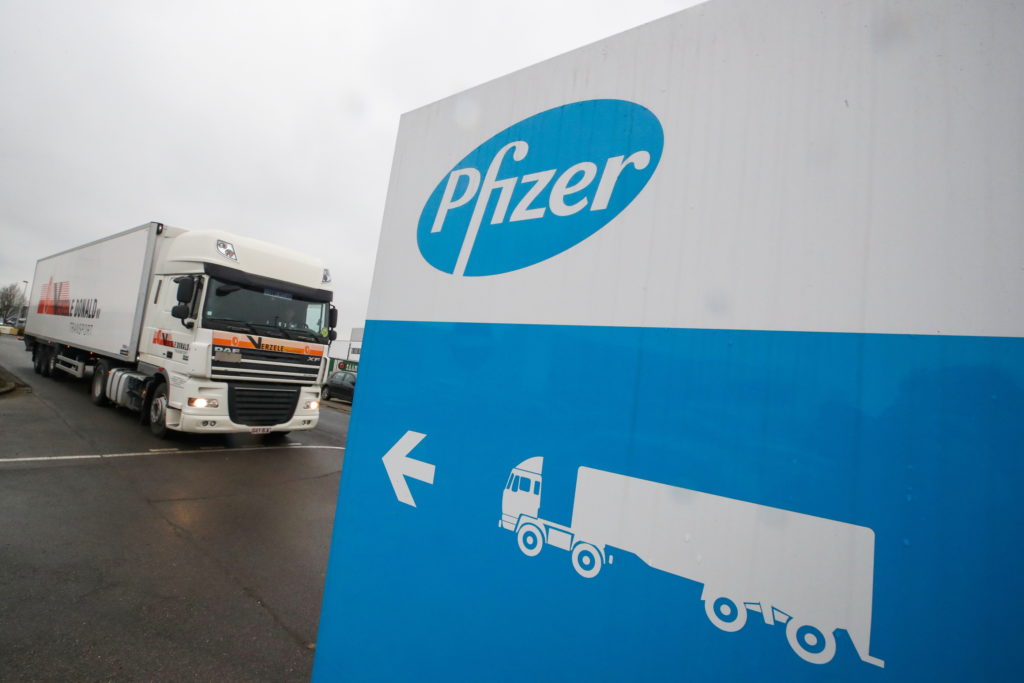The naked scientific truth on why the ongoing mass vaccination experiment drives a rapid evolutionary response of SARS-CoV-2
Critical opinion article> Geert Vanden Bossche (DVM, PhD)*
The ongoing denial by WHO, public health agencies and governments of science-based evidence on how to mitigate the already disastrous global and individual consequences of this pandemic are beyond mind-blowing. Whereas a number of medical doctors are now doing the utmost to make highly successful early multidrug treatment broadly accessible, I am contributing my part on analyzing the epidemiologic and health consequences of the ongoing mass vaccination campaigns and sharing – in all transparency – my insights with the broader public. From the critical opinion article below, it becomes already obvious that several scientists who are studying the evolutionary biology and genetic/ molecular epidemiology of this pandemic know too well that this pandemic is not over at all and that the global health risk posed by variants is very substantial. So, why do they keep silent?
I realize that the scientific language is not easily accessible to laymen. I hope the way I structured the article will, however, help them to grasp the key message.
Summary
As Sars-CoV-2 entered a highly susceptible human population, it has initially been spreading rapidly and in an uncontrollable way. This already explains why Sars-CoV-2 has been evolving rather slowly with no substantial selection of fitness-enhancing mutations occurring over the first 10 months of the pandemic (i.e., between December 2019 and October 2020). More infectious ‘variants of concern’ (VoCs, i.e., alpha [B.1.1.7], beta [B.1.351], gamma [P.1]) started to appear as of late 2020 and led to a steep increase in cases worldwide.
Molecular epidemiologists have observed that mutations within the Sars-CoV-2 spike (S) protein of these emerging, more infectious lineages are converging to the same genetic sites, a phenomenon that coincided with a major evolutionary shift in the landscape of naturally selected Sars-CoV-2 mutations (1).
Significant convergent evolution(*) of more infectious circulating Sars-CoV-2 variants is not a neutral, host-independent evolutionary phenomenon that merely results from increased viral replication and transmission but is strongly suggestive of natural selection and adaptation following a dramatic shift in the host(ile) environment the virus is exposed to (1).
Molecular epidemiologists fully acknowledge that the pandemic is currently evolving Sars-CoV-2 variants that “could be a considerably bigger problem for us than any variants that we currently know in that they might have any combinations of increased transmissibility, altered virulence and/or increased capacity to escape population immunity” (1). This is to say that phylogenetics-based natural selection analysis on circulating Sars-CoV-2 lineages strongly suggests that viral variants resistant to spike (S)-based Covid-19 vaccines are currently expanding in prevalence and highly suspicious of causing future epidemic surges globally.
Deployment of current Covid-19 vaccines in mass vaccination campaigns combined with the ongoing widespread circulation of Sars-CoV-2 can only increase immune selective pressure on Sars-CoV-2 spike protein and hence, further drive its adaptive evolution to circumvent vaccine-induced humoral immunity. In this regard, the expectation of an increasing number of vaccinologists matches the current observation made by genomic epidemiologists in that S protein-directed immune escape variants are highly likely to further spread and expedite the occurrence of viral resistance to the currently deployed and future (so-called ‘2nd generation’) Covid-19 vaccines.
To monitor the circulation of hazardous viral variants in the population and to be able to provide unequivocal proof of the immune selection pressure exerted by mass vaccination campaigns and the harmful consequences thereof, there is an urgent need for conducting representative viral sampling on vaccinees, including those who are healthy or only subject to mild disease, and to genetically characterize the variants they shed upon exposure to Sars-CoV-2.
Conducting a mass vaccination experiment at a global scale without understanding the mechanisms underlying viral escape from vaccine-mediated selection pressure is not only a colossal scientific blunder but, first and foremost, completely irresponsible from the perspective of individual and public health ethics.
In the absence of vaccines capable of inducing sterilizing immunity, early multidrug treatment as proposed by Prof. Dr. P. McCullough and others (https://pubmed.ncbi.nlm.nih.gov/33387997/), together with global chemoprophylaxis using highly efficient antiviral drugs, will be key to save lives, reduce the hospitalization burden and dramatically diminish transmission of highly infectious or neutralizing antibody (nAb)-resistant escape variants.
(*) Convergent evolution relates to the independent occurrence of one or more mutations that are shared in common across several viral variants
Preamble
There is currently a lot of confusion in regard of the effectiveness of Covid-19 vaccines with plenty of contradictory reports circulating in the literature and on social media. This in itself is probably providing the most convincing evidence that the pandemic situation is rapidly evolving and is currently transitioning a kind of ‘gray’ zone. A pandemic is typically to be considered a very dynamic event (until it merges into an endemic situation). However, the evolutionary dynamics of this Covid-19 pandemic have now been shaped by human intervention in a way that is completely unprecedented. We do know about the outcome of a natural pandemic but don’t know at all about the outcome of the ongoing pandemic, as the latter has now become a ‘pandemic of variants’. From what follows below (and which is basically a summary of findings made by molecular/ genomic epidemiologists that I put into a broader context), there is however, one certainty, which is that Sars-CoV-2 variants are rapidly evolving in response to the natural immune selection pressure they are experiencing. Phylogenetics-based natural selection analysis indicates that a substantial amount of the immune selection pressure exerted during this pandemic is directed at the Sars-CoV-2 spike (S) protein, which is targeted by the vaccines. On their journey to adapting to the host(ile) environment of neutralizing antibodies (nAbs), variants further exploit their evolutionary capacity to overcome this S-directed, population-level immune pressure. Hence, in a given vaccination setting and stage of the ongoing pandemic, the success of mass vaccination campaigns will to a large extent depend on the evolving prevalence of increasingly problematic variants. Alternatively, S-directed immune interventions that seem effective in one vaccination setting and stage of this pandemic may not work as well when applied to another vaccination setting or when implemented at another stage of the ongoing pandemic. The observation that the effectiveness of mass vaccination campaigns, as assessed during a pandemic of immune escape variants, oftentimes evolves very differently between countries or regions is, therefore, not surprising. It is only when the population-level selective immune pressure will culminate that variants and, therefore, the effects of these campaigns will start to globally converge to the same endpoint, which is ‘resistance’ to the vaccines. It is only at that very endpoint that all assessments of the alleged ‘effectiveness’ of this experiment will be unanimous and consistent. When exactly this will happen is still subject to speculation. However, as the immune selection pressure in the global population is now ‘massively’ rising and the set of naturally selected, S-directed mutations together with the plasticity thereof dramatically expanding, one can reasonably expect that the edition of a super variant capable of resisting S-specific Abs will be precipitated such as to emerge within the next few months. When second-generation vaccines will be introduced, the virus will only be building upon this versatile foundation of circulating mutations to rapidly circumvent the immune pressure the re-vaccinated population will continue to exert on the S protein.
“The most important issue here is not whether this particular “super variant” ever arises….” (1)
It is unbelievable how public health authorities (PHAs) are lagging behind when it comes to understanding the evolutionary capacity of Sars-CoV-2. Or do PHAs and policymakers simply ignore the observations made by world-class molecular epidemiologists? How can they possibly justify mass vaccination campaigns in light of all the scientific arguments pointing to the high likelihood that these campaigns will only expedite viral resistance to Covid-19 vaccines? Why are the scientists who are bringing all this evidence to the PAPER not bringing it to the TABLE? How can they predict that this pandemic is going to evolve even more problematic VoCs and keep silent? Why don’t they set up a forum of independent, knowledgeable experts providing indisputable and unanimously agreed evidence that the rhetoric put forward by the WHO and national health authorities is scientifically wrong? Don’t they realize that keeping silent about the ongoing disastrous – but for now still largely hidden- evolution of the pandemic is only going to provide more ammunition for governments to extend their mass vaccination campaigns such as to reach as high as possible vaccine coverage rates in the population? Why on one hand do molecular epidemiologists seriously consider that resistance to the vaccines may occur as a result of rapidly rising S-directed immune pressure in the population but on the other hand don’t ring the alarm bell? How can they acknowledge the effect of emergent viral variants on the efficacy of Covid-19 vaccines without overtly pointing to the risk that vaccines failing to block viral transmission will further shape the evolution dynamics of viral variants? How can they recognize that antibody(Ab)-based therapy (e.g., use of convalescent plasma and monoclonal Ab treatments) in immunocompromised, chronically ill patients promotes long-term viral shedding and may lead to the propagation of variants carrying Ab escape mutations while ignoring the likelihood for a similar effect to occur when mass vaccination enables an entire population to exert immune selection pressure on the very same immunodominant Sars-CoV-2 S protein (i.e., when large numbers of individuals are vaccinated while being exposed to the virus before having developed a full-fledged Ab response)? It cannot be that they don’t understand the disastrous consequences viral resistance to Covid-19 vaccines would imply! It cannot be either that they didn’t learn that the kinetics of natural selection of immune escape mutations are much slower (or even non-existent as in the case of the Influenza pandemic of 1918!) in the presence of naturally elicited immunity. Or don’t they realize that the type of immune priming following natural Sars-CoV-2 infection is very different from the one that results from prophylactic immunization with S-based vaccines? It is difficult to imagine they would not comprehend why under conditions of natural viral infection and transmission during a pandemic, the chances for freshly infected, immunologically naïve or previously infected subjects to become re-infected on a background of suboptimal S-specific Abs are much lower than for vaccinated people to become exposed to Sars-CoV-2 while not being armed with a high enough titer of full-fledged S-specific Abs.
In other words, if molecular epidemiologists would only realize that immune selection pressure exerted by S-directed Abs occurs much less frequently during a natural pandemic than in the course of mass vaccination campaigns, they would probably figure among the best placed scientists on earth to warn against the high likelihood for this virus to evolve immune evasion and, ultimately, to resist vaccinal nAbs as a result of mass vaccination. At any rate, they all recognize the need for careful systematic surveillance of the ongoing evolutionary immune escape, which currently translates in an enhanced expansion of variants comprising mutations that further converge as they continue to adapt to rising population immunity in general and S-specific Abs in particular (1).
Although population cohorts exerting selective S-directed immune pressure, (i.e., now increasingly consisting of vaccinees!) provide a breeding ground for S-associated immune escape mutations, health authorities seem to no longer be monitoring viral shedding and genetic characterization of viral samples in healthy or only mildly ill vaccinees. This is, of course, highly problematic as even asymptomatically infected vaccinees are known to shed virus and are now granted more freedom of movement and adhering less to social distancing measures. In this way, we are currently largely incognizant of the true prevalence and distribution of new variants and the speed at which they spread in the population. However, epidemiologists are not raising their voice to put an end to this grave public health negligence, even though they clearly seem to disagree with this practice: “As antigenically different variants are continuing to emerge, it will become necessary to routinely collect serum samples from vaccinated individuals and from individuals who have been infected with circulating variants of known sequence” (3); and further: “Defining these dynamics, and their potential influence on vaccine effectiveness, will require large-scale monitoring of SARS-CoV-2 evolution and host immunity for a long time to come” (4).
In the meantime, the WHO and their advising ‘experts’ are still preaching the ludicrous mantra that the more we vaccinate, the less the virus can replicate and hence, the lower the risk that VoCs will arise and become dominant in the viral population. Is it this mantra of mass vaccination that leads PHAs to conclude that monitoring of viral shedding in vaccinees has become obsolete? However, their simplistic interpretation of viral transmission dynamics would only apply to conditions of neutral genetic drift as occurring during the early phase of a pandemic, i.e., in a population of immunologically unprimed susceptible subjects that does not exert significant positive selection pressure on the virus prior to its host-to-host transmission (2). However, at this stage of the pandemic where a multitude of variants, including several VoCs, are already circulating, the real global health concern is no longer about the likelihood for yet another problematic variant to emerge but rather about the ongoing population-level selection pressure that is now driving particular mutations of concern to expand in prevalence. Ignoring the positive selection signals that are now increasingly observed within nAb-binding S domains inevitably leads to an underestimation of the evolutionary potential of Sars-CoV-2 to escape from these nAbs (2). However, instead of investigating the conditions that underlie this strong positive selection pressure, PHAs are doing the utmost to make people believe that mass vaccination will stop the transmission of these variants, lead to herd immunity and, therefore, put a stop to the Covid-19 pandemic. There is currently no single scientific argument or rationale to back any of these statements. On the contrary, numerous reports on breakthrough infections in vaccinees clearly illustrate that those who have not been immunized against Sars-CoV-2 are all but provided indirect protection by vaccinees (5, 14). The mantra that mass vaccination will at least contribute to controlling the pandemic is fully incoherent with the scientific knowledge gathered by molecular epidemiologists. Whereas phylogenetics-based natural selection analysis is a well-established method for studying evolutionary adaptation to enhanced host immune pressure, PHAs don’t seem to be impressed by data that are strongly suggestive of immune selection pressure resulting from human interventions targeting Sars-CoV-2 spike protein. Findings from this analysis indicate that as soon as a certain threshold of infectious pressure is reached, a sufficient number of subjects will harbor dominant mutants that could then spread across the entire population provided positive immune selection pressure is exerted by a substantial part of the population (1).
Some VoCs have already been observed before mass vaccination campaigns were initiated. Because they reproduce more effectively in the population, these antigenically different variants are referred to as ‘more infectious variants’. In order to adapt to the increased pressure exerted by rising population immunity, variants are now increasingly incorporating additional mutations converging to specific sites within the receptor-binding domain (RBD) of the virus and conferring resistance to multiple S-directed Abs (1). The ongoing convergent evolution of immune escape mutations may come with a fitness cost of new variants for as long as the contribution of the population exerting selective immune pressure is not high enough to enable its enhanced propagation in the host population. It is important to note, though, that multiple distinct point mutations can each evade a multitude of neutralizing Abs (2). This would already explain why very few mutations (e.g., within the RBD) could already lead to full resistance to vaccinal Abs. At this stage of the pandemic, mutations in the S protein that impact neutralizing Abs are already present at significant frequencies in the global viral population and evidence of expanding variants exhibiting a higher and higher level of resistance to vaccinal S-specific Abs is now accruing (3). In other words, it becomes increasingly obvious that Sars-CoV-2 immune escape variants are adapting to rising population immunity and improving on transmissibility by stepwise acquisition of new mutations (as shown, for example, by the recent expansion of the delta ‘plus’ variant in several countries). All of the above already explains why the ‘success’ as proclaimed by the WHO and other health authorities or advising experts merely relates to short-term assessments of morbidity, hospitalization and mortality rates. However, the data published by molecular/ genomic epidemiologists analyzing the ongoing adaptation of Sars-CoV-2 to the evolving immune selection forces at play in this pandemic of Sars-CoV-2 variants seem to indicate that the ‘success’ of current public health efforts will not last for much longer. This is because PHAs and their advising experts seem to ignore that mass vaccination campaigns conducted during a pandemic of variants fail to reduce the number of active infections to a level low enough to prevent natural selection of immune escape mutants (i.e., even including double or triple mutants!) and curtail their adaptation to a steadily rising population-level immune selection pressure, no matter the speed at which these campaigns are conducted. Their mantra that the acceleration of mass vaccination campaigns will prevent the virus from evolving variants that escape vaccine-induced immunity is, therefore, simply wrong. Since all of the current Covid-19 vaccines deployed in this mass vaccination program will contribute to raising immune selection pressure and eventually provide variants capable of evading S-specific Abs with a fitness advantage in the population (i.e., increasingly consisting of vaccinees!), neither herd immunity nor eradication could conceivably happen.
In conclusion: There is no way that the ongoing pharmaceutical (mass vaccination) and nonpharmaceutical interventions will prevent propagation of more infectious variants (those got already selected before the initiation of mass vaccination campaigns, presumably as a result of widespread implementation of stringent infection prevention measures) or variants comprising one or more RBD-associated nAb-resistant mutations. On the contrary, all evidence from molecular epidemiology indicates that the ongoing shift in natural selection forces exerted by the population on Sars-CoV-2 mutations is merely going to expedite the selection and propagation of more problematic variants of concern. It is beyond any doubt that growing vaccine coverage rates in the global population will further exploit the evolutionary capacity of Sars-CoV-2 to adapt to a higher and higher S-directed immune selection pressure until full vaccine resistance is achieved.
There is now compelling evidence that sets of convergent mutations that have emerged in the context of VoCs evolved in response to the changing immune profile of the population. It has been postulated that convergent evolution of mutations primarily occurs in previously infected individuals or as a result of chronic infections (15-20). However, vaccinated people are far more prone to breeding viral immune escape variants than non-vaccinated naturally infected individuals. Why?
In immunologically unprimed subjects, the peak of viral replication and shedding occurs well before host Ab responses appear. This already suggests that the host immune response in non-primed, S-sero-negative subjects (i.e., including previously asymptomatically infected subjects who lost their short-lived S-specific Abs) does not exert significant immune pressure on the virus(**). On the other hand, most countries started their vaccination campaigns before a substantial part of the population acquired immunity from natural infection. It is, therefore, reasonable to postulate that not natural infection or transmission but widespread deployment of vaccines is now becoming the primary cause of evolutionary selection pressure on viral expansion. This would already suggest that immune escape variants are now spreading rapidly in many parts of the world. It is fair to assume that the more widespread the presence of vaccinal S-specific Abs in the global population, the more the rate of evolutionary immune evasion from S-directed humoral immune pressure will rise. The frequent occurrence of suboptimal immune selection pressure exerted by virus-exposed vaccinees on Sars-CoV-2 spike protein will provide variants that are capable of evading S-specific vaccinal Abs with a selective transmission advantage. As already mentioned in previous contributions of mine, suboptimal S-directed immune pressure occurs in asymptomatically infected vaccinees who are still in the process of mounting Ab responses or possessing immature S-specific Abs (e.g., between 1st and 2nd injection of a 2-shot vaccine) or whose vaccinal Abs are low in titer and/ or not fully functional as a result of an immune compromised health status.
(**) There are two important exceptions. 1. If the number of active infections is very high (e.g., due to overcrowding and poor hygienic standards), the reservoir of people who are naturally susceptible to Covid-19 disease becomes rapidly exhausted. This will now provide a transmission advantage to more infectious variants harboring immune escape mutations that are capable of withstanding selective S-directed immune pressure exerted by short-lived Abs in previously asymptomatically infected individuals. When the infectious pressure is high, the likelihood for the latter to become re-infected shortly after their primary infection will increase and so will the likelihood of expansion of more infectious variants. 2. Likewise, selective immune pressure will be relevant in case stringent infection prevention measures targeted at controlling the pandemic are installed on a background of a sufficiently high infectious pressure. Under such conditions, viral transmission to naturally susceptible individuals is hampered and a similar type of more infectious variants may gain a transmission advantage when exposed to suboptimal S-specific humoral responses in previously asymptomatically infected individuals.
What determines the time required for Sars-CoV-2 to resist vaccinal Abs at a population level?
It is fair to assume that RBD-targeted immune selection pressure exerted on a background of previously selected mutations enabling enhanced viral infectiousness will expedite natural selection of new, nAb-escaping mutations. Hence, circulation of more infectious viral variants is likely to expedite convergent evolution of mutations, including such that enable viral resistance to S-directed Ab-mediated immunity elicited by the vaccines.
As a rule of thumb, the time for population-level anti-vaccine resistance to develop depends on
The transmission or fitness advantage of the nAb-resistant variant (2). This factor is dependent on both, the magnitude of the population-level selection pressure and the intrinsic evolutionary fitness cost. The higher the relative percentage of individuals with nAbs to a given epitope (i.e., the more widely a given epitope is targeted) and the lower the intrinsic evolutionary fitness cost (i.e., the more effective the ‘infectious’ function of the mutated epitope), the higher the transmission advantage of the nAb-resistant variant and hence, the faster the mutated epitope will generate resistance to nAbs that are targeting it. In the case of vaccines, however, resistance will require a combination of multiple RBD-targeted mutations. This is what is currently causing in several countries an insidious period of pandemic quiescence as it takes more time for the virus to acquire a combination of multiple mutations to overcome vaccine-induced immunity despite widespread immune selection pressure (so-called ‘fitness valley-crossing time’; 2). Full resistance to the vaccines can only occur through intermediate steps wherein immune escape variants progressively evolve to incorporate additional mutations that are required to eventually reach full resistance to the vaccine. As long as the acquired subset of mutations does not suffice to escape the population-level immune pressure induced by the vaccine, the overall transmission or fitness cost from the immune escape mutations will be higher than the overall transmission or fitness advantage provided by the selection pressure exerted by the expanding prevalence of nAbs in the population.
The mutation rate (2). This factor is dependent on both, the infectious viral pressure and the intrinsic mutability of the virus. The higher the mutation rate, the higher the likelihood that a combinatorial subset of mutations required for full-fledged resistance to the vaccine occurs. Viral variants may even harbor mutations outside of S protein that are subject to natural selection and thereby drive an enhanced mutation rate (21).
Intermediate immune escape variants (i.e., harboring only a subset of the mutations required for nAb escape) are characterized by a lower fitness level. However, fast-speed mass vaccination campaigns that are rolled out on a background of a relatively high infectious pressure will mediate a relatively strong population-level immune selection pressure (as vaccine coverage rates rise quite rapidly). All of this will expedite the evolution of intermediate lower fitness variants into nAb-resistant variants (e.g., USA case). Conversely, when a mass vaccination program is initiated on a background of low infectious pressure, transmission of intermediate lower fitness variants will be low and more time will be required for nAb-resistant mutants to establish in the population (e.g., Israel case). This has been motivating certain ‘experts’ and policymakers to precipitate their conclusions on the success of mass vaccination campaigns in that they pretend that the pandemic is increasingly getting under control!
It is fair to expect that the widespread presence of full-fledged, S-specific vaccinal Abs will eventually cause vaccine-resistant variants to dominate and further expand in the viral population. This is to say that ongoing mass vaccination campaigns will inevitably entail full resistance of Sars-CoV-2 to all S-targeting Covid-19 vaccines and are, therefore, highly likely to lead to an impressive wave of infection and disease in vaccinees, especially in those who have not previously experienced Covid-19 disease.
It suffices to acknowledge that the ongoing convergent evolution of new variants is driven by natural selection pressure to conclude that mass vaccination campaigns conducted in the heat of a pandemic are now promoting expansion of immune escape variants that vaccines will eventually no longer be capable of protecting against.
Whereas global and stringent infection containment measures may eventually have led to population-level selection of more infectious variants, increasing vaccine coverage rates are now likely to promote population-level selection of nAb-evading viral mutants. Viral VoCs that spontaneously arise as a result of viral replication cannot all of a sudden start to outcompete lineages that circulate in several different countries unless they acquire a competitive advantage. They can only acquire such an advantage if the environmental conditions they are exposed to change in ways that provide them with a transmission advantage when compared to the wild-type virus or previously circulating strains/ variants. Because some mutations will endow the virus with enhanced intrinsic viral infectiousness, viral variants comprising such mutations will naturally be selected when altered conditions in the host environment exert pressure on viral infectiousness. In this way, viral propagation and survival can be secured. Provided the selection pressure on viral infectiousness is widespread in the population, more infectious variants will rapidly gain a fitness advantage and quickly expand in the population. Dominance of such new viral variants is, therefore, indicative of natural selection of a virus that is more transmissible at a population level. However, the more the combination of mutations required for immune escape impacts viral fitness, the more time it will take immune escape variants to reach a high enough infectious pressure in the population or the more immune selection pressure will need to be exerted by the host environment to compensate for the incurred evolutionary fitness cost (see also below). Along the same lines of reasoning, it is fair to conclude that more infectious or nAb-resistant variants will expand in prevalence upon their introduction into countries where mass vaccination is already well advanced. These variants are, indeed, well adapted to the widespread immune selection pressure that has been generated in the population as a result of mass vaccination. Thanks to an excellent breeding ground, these variants will now reproduce more effectively than the previously circulating strains.
It is fair to postulate that the more widespread the presence of full-fledged, S-specific vaccinal Abs, the more readily variants will evolve resistance to the vaccines and eventually adapt to the immune environment they are exposed to as they spread in the host population. This is to conclude that ongoing mass vaccination campaigns will inevitably entail full resistance of Sars-CoV-2 to all S-targeting Covid-19 vaccines. This is highly likely to rapidly provoke a resurgence of Sars-CoV-2 infection and disease, especially in vaccinees. As already mentioned above, cases of severe disease would be expected to be more frequent amongt vaccinees who did not previously contract Covid-19 disease.
How can human behavior or infection prevention measures promote propagation of mutations in Sars-CoV-2 spike protein?
The natural host environment of Sars-CoV-2 can create several barriers that impact viral transmissibility and survival. Enactment of infection prevention measures or overcrowding are examples of situations threatening viral spread. As the infectiousness of Sars-CoV-2 is strongly shaped by the physicochemical properties of its spike protein, the above-mentioned obstacles will exert selection pressure on Sars-CoV-2 S protein and may, therefore, substantially contribute to natural selection of mutations that enable stronger binding affinity of S protein for the Ace-2 receptor of permissive cells. To adapt to such environmental constraints, viral variants have been shown to independently evolve to acquire multiple unique as well as convergent mutations (1). Convergent evolution of mutations comprised within S-associated, immunologically relevant genes are proof of natural selection and illustrate the evolutionary capacity of Sars-CoV-2 to adapt to S-targeted immune pressure.
Renowned experts in molecular epidemiology are now increasingly finding that the emergence and ongoing convergent evolution of Sars-CoV-2 variants coincides with a major global shift in the Sars-CoV-2 selective landscape (1). As this ongoing shift also coincides with globally conducted mass vaccination campaigns, the question arises as to whether these ongoing campaigns have the potential to foster convergence between evolving variants. This boils down to the following question:
Does mass vaccination with current Covid-19 vaccines enable populations to exert S-directed immune selection pressure?
This is, indeed, an important question: If mass vaccination enables the vaccinated population-to exert S-directed immune selection pressure, the likelihood that current Covid-19 vaccines will be able to control the pandemic should be seriously questioned for adaptive evolution of Sars-CoV-2 variants has already been shown to coincide with epidemic surges in multiple parts of the world. As already mentioned, most – if not all – of the above-mentioned evidence directly emerges from in-depth research conducted by internationally recognized molecular epidemiologists. These researchers acknowledge that rising population immunity and public health measures may complicate control of the pandemic by virtue of their positive selection effect on immune escape variants. However, they do not advance any hypothesis as to the underlying causes of rising immunity that leads to a transmission advantage for S-directed immune escape mutants other than through individuals who are chronically ill and sustain prolonged viral replication as a result of insufficient immune control. This is probably an area where molecular epidemiologists should synergize with immunologists to understand, for example, that during a pandemic previously asymptomatically infected subjects may become re-infected at a point in time where their innate CoV-nonspecific Abs are still suppressed by suboptimal S-specific Abs (which they acquired as a result from that previous asymptomatic infection). More importantly, molecular epidemiologists may find it useful to learn from vaccinologists as a better understanding of the immune priming by vaccines, as compared to natural infection, could inform a more targeted surveillance of viral mutations and variants. In this regard, it is important for them to understand that mass vaccination in the heat of a pandemic, much more than natural infection of immune suppressed subjects, provides a panoply of conditions for individuals to become infected while only harboring suboptimal, S-specific Abs. Suboptimal stimulation of S-specific Abs could be due to individual insufficiencies in immunological responsiveness to the vaccine but inevitably occurs in all vaccinees for as long as they are in the process of mounting their Ab response. This is particularly problematic in vaccinees who have not yet received the second shot of a 2-dose Covid-19 vaccine. In these vaccinees, the S-specific Ab response after the 1st dose will not suffice to control replication and transmission of more infectious viral variants. In addition, exposure of vaccinees to antigenically different variants is also to be considered a case of suboptimal S-specific Abs and would already explain why increasingly problematic variants (e.g., VoCs or other problematic immune escape variants with deletions in the N-terminal domain of S protein) are overrepresented in vaccine breakthrough infections (5,14). All of the above situations will enable a growing part of the population (vaccinees!) to exert selective immune pressure on the S protein when exposed to Sars-CoV-2 (which is all but a rare event during a pandemic!).
Unfortunately, vaccinees are not systematically monitored for shedding of antigenic Sars-CoV-2 variants and hence, the information on the type of variants they shed is scarce, the effective reproduction number largely underestimated and the evolutionary potential of the virus to evade S-specific Ab underexplored. As a result, reports on the relative distribution of variants are likely skewed to less problematic variants as those may still have a fitness advantage in vulnerable people compared to variants comprising a combination of nAb-resistant mutations.
As some sources of population-level selective pressure are known to be amenable to human intervention, there is an urgent need for systematic genomic sequencing of circulating variants in vaccinees as this would provide us with unambiguous evidence as to whether mass vaccination campaigns enable a population to exert immune-mediated selective pressure on critical functional characteristics of Sars-CoV-2 such as virulence, transmissibility and nAb-resistance.
Why will mass vaccination campaigns conducted in the midst of this pandemic inevitably cause viral immune escape at the population level, irrespective of the speed at which these campaigns are progressing?
It has been established that the threshold number of individuals required for natural selection is far lower than the threshold number for neutral genetic drift to drive evolutionary changes in the Sars-CoV-2 landscape (2). But also mathematical modelling has already shown that prophylactic nAb treatment (including vaccination) of a relatively low percentage of the population already suffices to provide an immune escape mutant impacting the neutralizing Ab capacity with a significant transmission advantage compared to the wild virus (2). In addition, mass vaccination campaigns conducted during a pandemic will inevitably enroll people who are exposed to an environment of relatively high infectious pressure. This will increase the likelihood for vaccinees to harbor a dominant double or even triple mutant that is capable of evading a multitude of nAbs and hence, likely to serve as a source for population-level resistance of Sars-CoV-2 to Covid-19 vaccines.
From a scientific perspective, it is impossible to imagine that the ongoing large-scale vaccination campaigns are not going to rapidly and globally breed vaccine-resistant mutants instead of generating vaccine-mediated herd immunity. As of early March 2021, I have, therefore, been warning several times against the rapid resurgence of Sars-CoV-2 morbidity and mortality rates that this evolution is now highly likely to cause, especially in vaccinees. Hence, I repeatedly called upon PHAs world-wide to immediately stop all mass vaccination campaigns.
Will the consequences of viral resistance to Covid-19 vaccines also affect non-vaccinated individuals?
Resistance to Covid-19 vaccines will only raise the infectious pressure and thereby increase the likelihood for non-vaccinated subjects to contract Covid-19 disease. On the other hand, nonfunctional vaccinal Abs in vaccinees could lead to Ab-dependent enhancement (ADE) of Covid-19 disease (2, 25). ADE is likely to shorten the pre-symptomatic phase of Covid-19 disease, viral shedding could be more easily and rapidly contained. Timely containment of viral transmission would contribute to diminishing exposure of non-vaccinated individuals to high infectious pressure. Provided unhampered functionality of their CoV-nonspecific innate Abs, diminished infectious pressure would likely protect non-vaccinated individuals from contracting Covid-19 disease. However, non-vaccinated individuals as well might be susceptible to ADE if they become exposed to Sars-CoV-2 while harboring S-specific nAbs as a result of natural infection. The risk may exist for as long as the concentration of these nAbs in their blood is high enough to outcompete innate, CoV-nonspecific Abs at the portal of viral entry. It is important to consider, though, that both, vaccinated and non-vaccinated subjects who previously contracted Covid-19 disease might be better protected against severe disease upon re-exposure thanks to the priming of protective, cytotoxic T cells.
Vaccine-elicited S-specific T cell responses against variants are largely preserved and have been suggested to enable robust vaccine efficacy against variants when the neutralizing capacity of vaccine-elicited Abs may not provide sufficient protection (11). Could vaccine-induced T cell immunity, therefore, diminish the prevalence of viral variants and mitigate resurgence of morbidity and mortality waves?
Some publications suggest that increased breadth in S-specific vaccinal CD8+ T cell responses in vaccinated as compared to non-vaccinated individuals may compensate for insufficient neutralization capacity of S-specific vaccinal Abs against a number of new, more infectious variants. This would, therefore, still enable vaccines to provide robust protective vaccine efficacy against emerging variants. It is unlikely, though, that largely preserved T cell responses against variants mediate S-specific killing of virus-infected cells. This is because killing by cytolytic CD8+ T cells (CTLs) is known to be genetically determined by protective MHC class I alleles. No evidence of promiscuous or universal, Sars-CoV-2 S-derived CTL epitopes has been reported. The robustness of protective vaccine efficacy against variants across a genetically heterogeneous host population can, therefore, not be explained by CTL-mediated killing as the latter would be MHC class I-restricted, even if S-derived CD8+ T cell epitopes are conserved. Robustness of protective vaccine efficacy against multiple variants is most likely due to innate, cytokine-mediated immune cascades that are largely triggered by polyfunctional, broadly preserved memory T cells. These cytokine-mediated responses likely synergize with nAbs to further reduce viral load (and hence, likely diminish the likelihood of [severe] disease) but fail to abrogate viral transmission or curtail the expansion of viral variants. This is because non-antigen(Ag)-specific innate immune responses cannot target and eliminate Sars-CoV-2-infected cells. It is reasonable to assume, however, that vaccine-elicited S-specific T cell responses will contribute to promote viral evasion from innate immune mechanisms when elicited in the context of large-scale vaccination campaigns during a pandemic. Innate immune evasion mechanisms are well known and have been extensively described (12, 13). This would ultimately results in a robust, universal (i.e., MHC-unrestricted) and nonAg-specific decline in vaccine efficacy towards all infectious Sars-CoV-2 variants.
Why are mass vaccination campaigns likely to increase Covid-19 morbidity and mortality rates?
From a purely scientific perspective and even regardless of all (important!) ethical issues they raise, mass vaccination campaigns conducted in the midst of a pandemic are doomed to fail and have unforeseeable health consequences, not only for individual vaccinees but also for the global human population.
As already mentioned, changes in the ‘traditional’ host environment (e.g., implementation of stringent public health measures and social distancing; overcrowding) may alter the evolutionary dynamics of the pandemic and drive natural selection and dominant propagation of more infectious variants (or, alternatively, promote their rapid expansion once they become de novo introduced into a population). Likewise, it is reasonable to assume that large-scale vaccination campaigns conducted during a pandemic will drive natural selection and dominant propagation of nAb-evasive variants. However, as viral adaptation evolves, replication and transmission of such naturally selected immune escape variants by asymptomatically infected or mildly ill vaccinees will become more and more frequent and eventually increase the risk of rapid re-exposure for non-vaccinated, previously asymptomatically infected individuals. This is now likely to prompt a new wave of morbidity and mortality in the non-vaccinated part of the population. Iin countries where mass vaccination campaigns are rolled out on a background of low infectious pressure, it will take more time for rising vaccine coverage rates to drive convergent evolution of additional, naturally selected mutations such as to ensure viral persistence in the face of a stronger and more widespread vaccine-induced immune response. However, there shall be no doubt that the endgame of this convergent evolution of vaccine-mediated immune escape mutants is full resistance of Sars-CoV-2 to the Covid-19 vaccines. When this happens, vaccinees in particular will become extremely vulnerable to Covid-19 disease as they will no longer be able to rely on their innate Abs for those will be outcompeted by their vaccinal Abs for binding to S protein.
It is important to note that it suffices for the virus to escape S- or RBD-directed immune pressure in order to become more infectious or to resist protective (neutralizing) vaccinal Abs, respectively. As neither previously asymptomatic, non-vaccinated individuals nor previously immunologically naïve vaccinees have experienced protective T cell priming, immune evasion from S-specific Abs is sufficient for Sars-CoV-2 to cause Covid-19 disease in these people. Given the intensity of natural selection signals observed in the current genomic landscape of Sars-CoV-2 spike protein (1), it is reasonable to assume that a further rise in population-level immune selection pressure on this protein (i.e., as a result of continued mass vaccination campaigns) will ultimately provide variants capable of evading a full set of vaccinal Abs (including those raised by 2nd generation vaccines) with a transmission advantage. As already mentioned, this is expected to dramatically raise morbidity and mortality rates in vaccinees.
Why are most countries not yet affected by enhanced circulation of increasingly immune resistant variants despite an advanced stage of their mass vaccination campaigns?
Full-fledged vaccine resistance is not yet observed as it may take much longer for a combination of multiple synergizing immune escape mutations to occur in a sufficient number of individuals in the population. However, once these immune escape variants are present in sufficient frequency, they will establish rapidly in populations that are subject to mass vaccination (due to widespread S-directed immune selection pressure). It is, however, important to note that during this period of pandemic quiescence, vaccination may lead to an increased risk of ADE as S protein from intermediate variants, which possess only a subset of the S-associated mutations required for full resistance to the vaccine, may still be recognized (but not neutralized) by vaccinal Abs (see above).
Will mass vaccinations have a different outcome depending on geographic and/ or demographic factors?
Regardless of the current evolutionary dynamics of the pandemic in any given country, immune escape variants will ultimately converge to a common adaptive endpoint, which is full resistance to S-directed nAbs induced by Covid-19 vaccines or resulting from natural infection. The speed at which Sars-CoV-2 is expected to develop resistance to S-specific nAbs induced by the current vaccines or acquired following natural infection will – among other, above-mentioned factors – depend on the speed at which mass vaccination campaigns are conducted. Enrolling youngsters and children in these mass vaccination campaigns is only going to rapidly expand the breeding ground for nAb-resistant variants and expedite the evolution depicted above.
Why are follow-up vaccines using key nAb epitopes from variant-associated spike protein unlikely to solve the issue of immune escape variants?
First, spike RBD displays a high level of evolutionary versatility whereas Covid-19 vaccines only induce a relatively narrow immune response (i.e., directed at a few immunodominant domains within a single viral protein). It is, therefore, reasonable to assume that the evolutionary capacity of Sars-CoV-2 to evolve variants capable of evading multiple nAbs reaches far beyond the breadth of S-associated epitopes Covid-19 vaccines can possibly target (2, 3, 9). This already suggests that these vaccines are highly likely to drive mutation-mediated escape from S-specific host Abs.
Upon re-vaccination with updated S-targeting vaccines (so-called ‘second generation’ vaccines), previously vaccinated people will rapidly recall their original vaccinal Abs while those who are waiting for their updated vaccine shot may do so as a result from natural exposure (as the virus will, indeed, still be circulating, primarily among asymptomatically infected vaccinees). In immunology, this phenomenon is known as ‘antigenic sin’. Consequently, a high level of S-directed immune selection pressure will be maintained within the vaccinated population, thereby promoting further expansion of viral variants and accelerating the speed at which variants will evolve a repertoire of additional immune escape mutations that is sufficient to eventually enable full resistance to the updated vaccine as well. In this context, it is also important to note that one single additional mutation could suffice to abolish the enhanced neutralization capacity of the updated vaccine by virtue of epistatic interaction between the additional mutation and multiple previously established adaptive mutations targeted by vaccinal nAbs. In addition, molecular epidemiologists are increasingly worried about a potential expansion of recombination-generated combinations of immune escape mutations as those could occur during co-infections with different variants and generate even more problematic variants of concern that will better match the evolving fitness landscape of the continuing pandemic (1, 9).
When high infectious pressure coincides with high immune selection pressure, partially resistant variants can be expected to transit more rapidly through the ’valley of lower fitness’ and hence, expedite the emergence of dominant variants that fully resist the updated vaccines. This is to say that steadily increasing vaccine coverage rates combined with relaxed infection prevention measures and global expansion in prevalence of more infectious variants are now serving as a breeding ground for upcoming nAb-resistant variants.
Re-vaccination with second generation vaccines is all but comparable with seasonal updates of Influenza vaccines as the latter are administered on a background of herd immunity. Dedicated molecular epidemiologist seem to recognize the likelihood that updated S-based Covid-19 vaccines may fail and state that “Further studies may be required to understand the risk immune evasion poses to a strategy of annually updated vaccines” (2).
Could an immediate and global halt of mass vaccination campaigns still prevent the emergence of more harmful viral recombinations or resistance of Sars-CoV-2 to Covid-19 vaccines?
A global and immediate halt of mass vaccination campaigns would allow to diminish immune selective pressure exerted on sites within the S protein that mediate nAb evasion. However, at this fairly advanced stage of the global mass vaccination program, it is probably already too late to prevent viral resistance to S-Abs, even if mass vaccination campaigns would immediately and globally be halted, and even though vaccine coverage rates are still fairly low in a number of low-income countries. This is because
nAb-resistant virus selected in a particular population will easily adapt and expand upon their introduction into other populations that are undergoing a similar shift in the Sars-CoV-2 fitness landscape, even though the local variants they are harboring are less advanced in their adaptive process of evolutionary convergence of immune escape mutations
the current spectrum of escape mutations already lays the groundwork for multiple recombinations to occur as viral spread continues. Combinations of immune escape mutations more readily enable variants to circumvent vaccine-induced immunity or acquire other phenotypic characteristics that could potentially be more harmful (1, 2, 3, 9). Some of these combinatorial variants could, therefore, be more problematic than those which circulated before.
Consequently, it is reasonable to assume that an immediate halt of all Covid-19 vaccination campaigns could at most delay full resistance of Sars-CoV-2 to the vaccines by a few months. However, recombinations are likely to lead to super variants with unpredictable phenotypic characteristics, some of which may be responsible for a further increase in viral infectiousness and/ or virulence or could even enable adaptation to another mammalian species (7). As already mentioned, recombinations are promoted by co-infection with different variants. At this stage of the pandemic, co-infection with different variants becomes increasingly likely as infection prevention measures are now being relaxed in many countries (9). Adaptation to other mammalian species may result from enhanced binding affinity of mutated spike protein for their Ace-2 receptor (e.g., in case of the Sars-CoV-2 Y453F mink variant) and generate an additional asymptomatic reservoir for recurrent transmission to humans (4).
Unless aggressive multidrug treatment is implemented at an early stage of disease and large-scale chemoprophylaxis campaigns are conducted, resistance of Sars-CoV-2 to Covid-19 vaccines is, most certainly, going to provoke a steep incline of morbidity and mortality rates in vaccinees, especially in those who did not contract Covid-19 disease prior to vaccination.
Are scientists suspicious of mass vaccination enhancing expansion of vaccine-resistant Sars-CoV-2?
In this regard, it suffices to cite D. Van Egeren et al. (2):
“Evidence from multiple experimental studies showing that single RBD point mutations can lead to resistance to neutralizing convalescent plasma from multiple donors suggests that specific single mutants may be able to evade spike-targeting vaccinal immunity in many individuals and rapidly lead to spread of vaccine-resistant SARS-CoV-2. One variant that can escape convalescent plasma neutralization is already circulating in South Africa and could experience greater positive selection pressure once vaccines are deployed widely”. These authors further suggest that natural selection of multiple mutations in individuals possessing nAbs against Sars-CoV-2 spike protein “could accelerate the emergence of vaccine-resistant strains in the months following vaccine deployment” and state that “Further studies are required to understand the risk immune evasion poses to a strategy of annually updated vaccines”. Additional citations from scientists studying the evolutionary biology of Sars-CoV-2 go as follows:
“… vaccines themselves represent a selection pressure for evolution of vaccine-resistant variants…” (9).
The notion that vaccines have the capacity to drive immune evasion of mutable pathogens and enable dominance of antigenically different variants with altered biological characteristics when deployed at population scale is certainly not new (8, 13, 22). This knowledge combined with the remarkable ability of Sars-CoV-2 to rapidly adapt to new environments and different hosts, in particular via convergent evolution of specific spike mutations (7, 23, 24), led at least some scientists to state that “With increasing levels of host immunity helped by the deployment of vaccines and ongoing widespread SARS-CoV-2 circulation, we fully expect to see increased evidence for adaptive evolution in Spike and other genes…” (7) or that “Mutations affecting the antigenic phenotype of SARS-CoV-2 will enable variants to circumvent immunity conferred by natural infection or vaccination” (3). Other scientists come to the following conclusions: “Subsequently, many other changes in the spike protein were found to propagate rapidly, showing that the bulk of the selection pressure on this protein comes from adaptation to the host. We can therefore anticipate that this protein, and to a lesser extent the nucleocapsid protein, will evolve most rapidly under the selection pressure of vaccination” (9) or: “However, there is growing evidence that mutations that change the antigenic phenotype of SARS-CoV-2 are circulating and affect immune recognition to a degree that requires immediate attention”. But scientists also acknowledge that a recombination event within Sars-CoV-2 variants or between a Sars-CoV-2 variant and Sars-CoV-2 from bats could be highly problematic in terms of precipitating resistance to the vaccines: “Due to the high diversity and generalist nature of these Sarbecoviruses, a future spillover, potentially coupled with a recombination event with SARS-CoV-2, is possible, and such a ‘SARS-CoV-3’ emergence could be sufficiently divergent to evade either natural or vaccine-acquired immunity, as demonstrated for SARS-CoV-1 versus SARS-CoV-2. We must therefore dramatically ramp up surveillance for Sarbecoviruses at the human–animal interface and monitor carefully for future SARS-CoV emergence in the human population” (7).
Biologists studying the genomic composition of CoVs in general and that of CoV-2 in particular published convincing evidence that also innate, nonAg-specific antiviral immune responses exhibited by infected host tissues (i.e., not only including lymphoid tissue!) exert immune selection pressure that shapes the genomic composition of infecting CoVs (10). As already mentioned above, vaccine-mediated T cell immunity is thought to contribute to protection by virtue of the innate immune cascades they stimulate.
It is generally agreed amongst molecular epidemiologists that resistance to nAbs and hence, to vaccine-induced immunity, could considerably be delayed by reducing the number of active infections (i.e., infectious pressure) in ways that do not exert a specific selective pressure on the virus. They literally state: “In this context, vaccines that do not provide sterilizing immunity (and therefore continue to permit transmission) will lead to the buildup of large standing populations of virus, greatly increasing the risk of immune escape”(2).
It is almost impossible to believe that scientists studying the genomic/ molecular epidemiology or evolutionary biology of Sars-CoV-2 would not understand that mass vaccination campaigns promote natural selection and propagation of immune escape variants when they all come to the conclusion that selective immune pressures exerted by antiviral host immune responses provide fitness-enhancing mutations with a transmission advantage enabling their adaptation to the infected host (tissue)-specific environment. In light of all scientific evidence provided and the sinister perspective of the current evolution when put in an immunological and vaccine context, knowledgeable scientists should feel a moral and ethical obligation to loudly voice their concerns publicly. It is appalling that some leaders of the very institutes disclosing some of these critically enlightening data on the evolutionary molecular dynamics of circulating variants seem to be denying the observations of their co-workers and continue to blindly advocate for mass vaccination. Instead, some of them are even bold enough to encourage arrogant and scientifically illiterate fact-checkers to misrepresent compelling scientific evidence as a hoax and debunk experts who put their career on the line in making this critically important information accessible to the broader public.
Compassionate scientists who have been taking a deep dive in these complex matters are now increasingly left with the impression that health authorities and advising experts will simply continue to deny that they are desperately wrong, no matter how compelling the scientific evidence that has been brought to the table and no matter the consequences this unprecedented public health experiment may involve for many years to come.
*Bio>
Geert Vanden Bossche received his DVM from the University of Ghent, Belgium, and his PhD degree in Virology from the University of Hohenheim, Germany. He held adjunct faculty appointments at universities in Belgium and Germany. After his career in Academia, Geert joined several vaccine companies (GSK Biologicals, Novartis Vaccines, Solvay Biologicals) to serve various roles in vaccine R&D as well as in late vaccine development. Geert then moved on to join the Bill & Melinda Gates Foundation’s Global Health Discovery team in Seattle (USA) as Senior Program Officer; he then worked with the Global Alliance for Vaccines and Immunization (GAVI) in Geneva as Senior Ebola Program Manager. At GAVI he tracked efforts to develop an Ebola vaccine. He also represented GAVI in fora with other partners, including WHO, to review progress on the fight against Ebola and to build plans for global pandemic preparedness.
Back in 2015, Geert scrutinized and questioned the safety of the Ebola vaccine that was used in ring vaccination trials conducted by WHO in Guinea. His critical scientific analysis and report on the data published by WHO in the Lancet in 2015 was sent to all international health and regulatory authorities involved in the Ebola vaccination program. After working for GAVI, Geert joined the German Center for Infection Research in Cologne as Head of the Vaccine Development Office. He is at present primarily serving as a Biotech/ Vaccine consultant while also conducting his own research on Natural Killer cell-based vaccines.
Bibliography
https://pubmed.ncbi.nlm.nih.gov/33688681/
https://pubmed.ncbi.nlm.nih.gov/33909660/
https://pubmed.ncbi.nlm.nih.gov/34075212/
https://pubmed.ncbi.nlm.nih.gov/33404586/
https://www.medrxiv.org/content/10.1101/2021.05.23.21257679v1
https://www.biorxiv.org/content/10.1101/2021.05.19.444774v1
https://pubmed.ncbi.nlm.nih.gov/33711012/
https://pubmed.ncbi.nlm.nih.gov/17210532/
https://pubmed.ncbi.nlm.nih.gov/33769683/
https://pubmed.ncbi.nlm.nih.gov/33351847/
https://pubmed.ncbi.nlm.nih.gov/34107529/
https://pubmed.ncbi.nlm.nih.gov/33953325/
https://pubmed.ncbi.nlm.nih.gov/33101306/
https://www.medrxiv.org/content/10.1101/2021.05.23.21257668v2
Kemp, S. A. et al. SARS- CoV-2 evolution during treatment of chronic infection.
Nature https://doi.org/ (2021).
Choi, B. et al. Persistence and evolution of SARS- CoV-2 in an immunocompromised host.
N. Eng. J. Med. 383, 2291–2293 (2020).
Avanzato, V. A. et al. Case study: prolonged infectious SARS- CoV-2 shedding from an asymptomatic immunocompromised individual with cancer.
Cell 183, 1901–1912 e1909 (2020).
Naveca, F. et al. SARS- CoV-2 Reinfection by the New Variant of Concern (VOC) P.1 in Amazonas, Brazil.
https://virological.org/t/Sars- cov-2-reinfection- bythe-new-variant- of-concern- voc-p-1-in-amazonasbrazil/596 (2021).
Nonaka, C. K. V. et al. Genomic Evidence of a SARSCov-2 Reinfection Case with E484K Spike Mutation in Brazil.
https://www.preprints.org/manuscript/202101.0132/v1 (2021)
Rambaut A. et al. Preliminary genomic characterization of an emergent SARS-CoV-2 lineage in the UK defined by a novel set of spike mutations.
SARS-CoV-2 coronavirus/nCoV-2019 Genomic Epidemiology—Virological (2021)
Duffy S. Why are RNA virus mutation rates so damn high?
PLoS Biol. (2018)
https://doi.org/10.1371/
Read A.F. et al. Imperfect Vaccination Can Enhance the Transmission of Highly Virulent Pathogens.
https://journals.plos.org/plosbiology/article?id=10.1371/journal.pbio.1002198 (2015)
https://doi.org/10.1371/journal.pbio.1002198
Tegally H. et al. Emergence and rapid spread of a new severe acute respiratory syndrome-related coronavirus 2 (SARS-CoV-2) lineage with multiple spike mutations in South Africa.
medRxiv. 2020
Epidemiology. https://doi.org/10.1101/2020.12.21.20248640
Gu, H. et al. Adaptation of SARS-CoV-2 in BALB/c mice for testing vaccine efficacy.
Science 443 369, 1603–1607(2020)
https://doi.org/10.1126/science.abc4730
Lee W.S. et al. Antibody-dependent enhancement and SARS-CoV-2 vaccines and therapies.
Nature Microbiology (2020) 5: 1185–1191. https://doi.org/10.1038/s41564-020-00789-5










